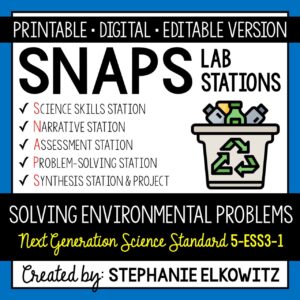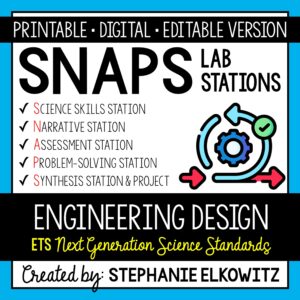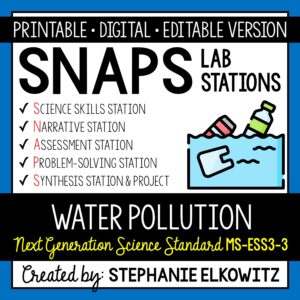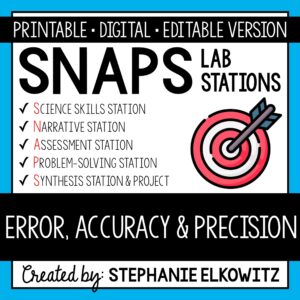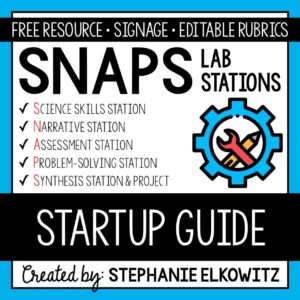MS-ESS3-3 Air Pollution Lab
$7.00
An engaging lab activity designed to enhance students’ understanding of scientific concepts and help students apply scientific ideas to the real world. Aligned with NGSS MS-ESS3-3.
Description
MS-ESS3-3 Air Pollution Lab Preview
SNAPs Lab Stations Activities require students to use science, math, literacy, problem-solving and engineering skills. They are designed to enhance students’ understanding of scientific concepts and help students apply scientific ideas to the real world. Each station activity promotes skills so to develop students into proficient and competent scientific thinkers.
SNAPs lab activities have five components:
• Science Skills Station to develop science skill proficiency
• Narrative Station to build science literacy
• Assessment Station to evaluate learning and understanding
• Problem-Solving Station to foster engineering design
• Synthesis Station and Project to inspire higher-order learning
DIGITAL LABORATORY – DISTANCE LEARNING & DIGITAL CLASSROOMS
• This lab is offered in a digital format to support digital classrooms & distance learning.
• The digital lab activity is designed to work with Google Slides and Microsoft PowerPoint
• The digital lab activity CANNOT be edited. However:
– Students can manipulate text boxes
– Students can create tables, graphs and diagrams
– Students can insert images and drawings
GOOGLE FORM ASSESSMENT STATION
• The assessment station is offered as a self-grading Google Form.
• Questions are all short answer and are 100% editable.
• Suggestions for use are included in the download.
DISTANCE LEARNING COMPATIBILITY
SNAPs lab activities are rated for their ease with distance – independent learning. Refer to the preview for more information about how well this laboratory works in a fully digital classroom and with distance learning.
EDITABLE DOCUMENTS
This download includes an editable word document (docx file) of all lab components:
• Pre-Lab and Post-Lab Activities
• The Lab Overview
• Lab Station Activities and Questions
• Directed Synthesis Project (when applicable)
Important Notes:
• Diagrams, illustrations, tables and graphs essential to lab activities are included
• Illustrative clipart is NOT included
• Editable documents and rubrics are included with the FREE SNAPs Setup Guide
Editable files allow you to:
• Edit the scope of the activities so to suit your students’ needs
• Edit the materials required based on resource availability
• Create single-period “mini-labs” using activities at the individual skills stations
The activities at each station in this lab are detailed below.
Air Pollution Lab Stations Activity Learning Objectives:
1. Identify examples of air pollution.
2. Analyze data so to understand air quality.
3. Evaluate the harm air pollution causes to the biosphere.
4. Assess the practicality, cost and effectiveness of methods and tools that help us reduce air pollution.
Science Skills Station
Students will study air quality at this station. Students will analyze the air quality of major US cities and trends in the number of unhealthy air quality days in those cities over the past 15 years. Students will also analyze the sources of the pollutants that most significantly impact air quality at the surface of the Earth.
Narrative Station
Students will read one informational text about the sources of air pollution and the negative impact of air pollution. Students will read a second information text about the adverse health effects of air pollution. Students will learn about the acute and chronic effects of short and long-term exposure to air pollutants.
Assessment Station
At this station, students will answer questions about key terms and ideas relating to air pollution. Students must employ lower, mid and higher order thinking skills to answer these questions.
Problem-Solving Station
Students will evaluate the benefit, cost and practicality of solutions developed by scientists, engineers and lawmakers that combat air pollution. Students will conduct research to determine the solutions that are most effective and feasible.
Synthesis Station
Students will compose a CER (claim-evidence-reasoning) report to summarize the lab. Students are provided the claim statement and must support the claim with observations, data and other information gathered in the lab. Students will explain how the evidence supports the claim using scientific reasoning.
Synthesis Project
Students will have a choice of 11 projects. Refer to the SNAPs Lab Stations Best Practices and Setup Guide for directions and suggestions on how to conduct the project.
Directed Synthesis Project
Students can conduct one of the 11 standard synthesis projects, but I strongly suggest using the directed synthesis project to supplement NGSS MS-ESS3-3. In the directed project, students will create a trifold pamphlet to summarize important facts and predictions about air pollution. Students will conduct research and summarize their findings in the pamphlet.
This download includes:
• A pre-lab assignment and post-lab reflection
• Directions and questions for each lab station
• Student recording sheets
• Teacher Key
Additional Materials Required:
Protractors
1 Computer or tablet
NEXT GENERATION SCIENCE STANDARDS
This laboratory satisfies NGSS MS-ESS3-3. It combines the three dimensions of science learning – science and engineering practices, disciplinary core ideas and crosscutting concepts – to meet the standard. This lab also makes interdisciplinary connections to STEM, Math CCSS and ELA CCSS to build the appropriate skills.
TERMS OF USE
• All rights reserved by Stephanie Elkowitz.
• This product is to be used by the original purchaser only.
• Intended for classroom and personal use only.
• Copying for more than one teacher, classroom, department, school, or school system is prohibited.
• This product may not be distributed or displayed digitally for public view.
• Failure to comply is a copyright infringement and a violation of the Digital Millennium Copyright Act (DMCA).




